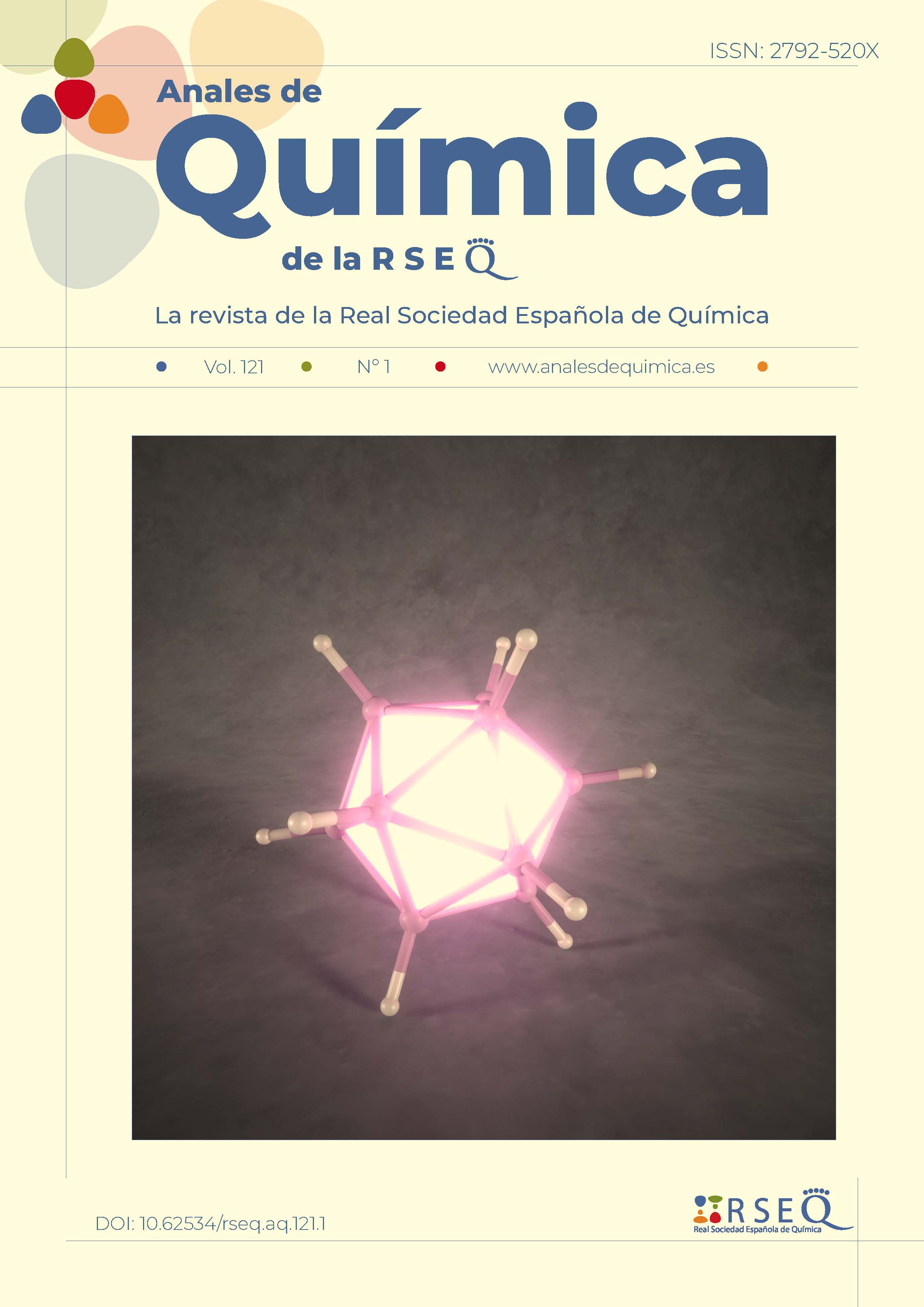Abstract
A brief historical analysis is carried out concerning the vectorial representation of the electric dipolar moment in chemistry. This convention, which is the opposite of the one adopted in physics, has its origin in the works that Sidgwick published in the early 1930s and was consolidated in the following decades. Specifically, authors of chemistry textbooks mostly adopted the chemical direction of this vector. Only at the end of the last century did some authors of physical chemistry textbooks begin to use the physical convention, but organic chemistry and general chemistry textbooks still follow the historical tradition of drawing an arrow pointing toward the most electronegative atom of a covalent bond, with a + sign at its tail. It is concluded that this representation does not involve holding any misconception, contrary to what some authors have pointed out.
References
O. Val-Castillo, An. Quím. RSEQ 2024, 120(1), 32-35, 10.62534/rseq.aq.1963.
J.W. Hovick, J.C. Poler, J. Chem. Educ. 2005, 82(6), 889, https://doi.org/10.1021/ed082p889.
A. Stone, The Theory of Intermolecular Forces, Oxford, 2013, https://doi.org/10.1093/acprof:oso/9780199672394.001.0001.
J.M. Herbert, J. Phys. Chem. A 2021, 125, 7125−7137, https://doi.org/10.1021/acs.jpca.1c05962.
P. Debye, Physik. Z. 2012, 13, 97-100, https://doi.org/10.1002/andp.19123441404.
J.J. Thomson, Philos. Mag. 1914, 27, 757-789, https://doi.org/10.1080/14786440508635150.
J.J. Thomson, Philos. Mag. 1923, 46, 497-514, https://doi.org/10.1080/14786442308634273.
C.P. Smyth, S.O. Morgan, J. Am. Chem. Soc. 1927, 49(4), 1030-1038, https://doi.org/10.1021/ja01403a022.
J.W. Williams, J. Am. Chem. Soc. 1928, 50(9), 2350-2357, https://doi.org/10.1021/ja01396a005.
J.W. Williams, Chem. Rev. 1930, 6(4), 589-619, https://doi.org/10.1021/cr60024a008.
L.E. Sutton, Trans. Faraday Soc. 1934, 30, 789-801, https://doi.org/10.1039/TF9343000789.
D. Ll. Hammick, R.C.A. New, N.V. Sidgwick, L.E. Sutton, J. Chem. Soc. 1930, 1876-1887, https://doi.org/10.1039/JR300001876.
N.V. Sidgwick, Chem. Rev. 1931, 9(1), 77-88, https://doi.org/10.1021/cr60032a003.
N.V. Sidgwick, Some Physical Properties of the Covalent Link in Chemistry. Cornell University Press. 1933.
C.K. Ingold, Chem. Rev. 1934, 15(2), 225-274, https://doi.org/10.1021/cr60051a003.
W.A. Waters, Physical Aspects of Organic Chemistry. Routledge. 1935.
H.R. Davidson, J. Chem. Educ. 1950, 27, 598-603, https://doi.org/10.1021/ed027p598.
H. Lumbroso, Annales de la faculté des sciences de Toulouse 4e série, 1950, 14, 7-130, https://doi.org/10.5802/afst.444.
L.E. Sutton, en Determination of Organic Structures by Physical Methods (Eds.: E.A. Brande, F.C. Nachod), Academic Press. 1955, pp. 373-425, https://doi.org/10.1016/B978-1-4832-3166-2.50013-5.
V.I. Minkin, O.A. Osipov, Y.A. Zhsanov, Dipole moments in organic chemistry, Plenum Press, 1970, https://doi.org/10.1007/978-1-4684-1770-8.
G.J. Moody, J.D.R. Thomas, Dipole moments in inorganic chemistry, Edward Arnold, 1971.
C. Párkányi, Theoretical Organic Chemistry, Elsevier, 1998.
G.E.K. Branch, M. Calvin, The Theory of Organic Chemistry, Prentice-Hall, 1941.
A. Bernthsen, J.J. Sudborough, A Textbook of Organic Chemistry, Blackie & Son, 1941.
S. Glasstone, Physical Chemistry, MacMillan, 1946.
L. Pauling, General Chemistry, Allied Pacific, 1953.
L. Pauling, College Chemistry, Freeman, 1957.
L. Pauling, The Nature of Chemical Bond, Cornell University, 1960.
G.M. Barrow, Química Física, Reverté, 1975.
M. Díaz, A. Roig, Química Física, Alhambra, 1978.
A.W. Adamson, A Textbook Physical Chemistry, Academic Press, 1979.
K.J. Laidler, J.M. Meiser, Physical Chemistry, Benjamin, 1982.
J. Levisalles, B. Castro, Química Orgánica, Dossat, 1980.
T.W.G. Solomons, Química Orgánica, Limusa, 1982.
K.P C. Vollhardt, N.E. Shore, Química Orgánica, Omega, 1996.
G.W Castellan, Physical Chemistry, Addison-Wesley, 1971.
J. Casabó, Estructura Atómica y Enlace Químico, Reverté, 1996.
L.G. Wade, Química Orgánica. Pearson. 2004.
J. Clayden, N. Greeves, S. Warren, Organic Chemistry, Oxford, 2012, https://doi.org/10.1093/hesc/9780199270293.001.0001.
R.J. Ouellette, J.D. Rawn, Organic Chemistry. Structure, Mechanisms and Synthesis. Elsevier. 2014.
F.A. Carey, R.M Giuliano, Química Orgánica, McGrawHill, 2014.
P. Yukanis, Fundamentos de Química Orgánica, Pearson, 2015.
J. McMurry, Organic Chemistry, Cengage, 2016.
P. Atkins, J. de Paula, Atkins’ Physical Chemistry, Oxford University Press, 2006.
P. Atkins, J. de Paula, Elements of Physical Chemistry, Oxford University Press, 2009.
R.G. Mortimer, Physical Chemistry, Elsevier, 2008.
P. Atkins, L. Jones, Principios de Química. Los caminos del descubrimiento, Panamericana, 2006.
R.H. Petrucci, F.G. Herring, J.D. Madura, C. Bisonnette, Química General. Principios y aplicaciones modernas, 2011.
T.L. Brown, H.E. LeMay, B.E. Bursten, C.J. Murphy, P.M. Woodward, Chemistry. The central science, Pearson, 2012.
R. Chang, J. Overby, Química, McGrawHill, 2020.
W. Whitten, R. Davis, M.L. Peck, G.G. Stanley, Química, Cengage, 2015.
I. Mills, T. Cvitaš, K. Homann, n. Kallay, K. Kuchitsu. Quantities, Units and Symbols in Physical Chemistry. Blackwell. 1993.
E.R. Cohen, T. Cvitaš, J.G. Frey, B. Holmström, K. Kuchitsu, R. Marquart, I. Mills, F. Pavese, M. Quack, J. Stohner, H.L. Strauss, M. Takami, A.J. Thor, Quantities, Units and Symbols in Physical Chemistry, Blackwell, 2007.
IUPAC Compendium of Chemical Terminology - the Gold Book, disponible en https://old.goldbook.iupac.org/html/E/E01929.html, 2014 (consultado 16/11/2024).



